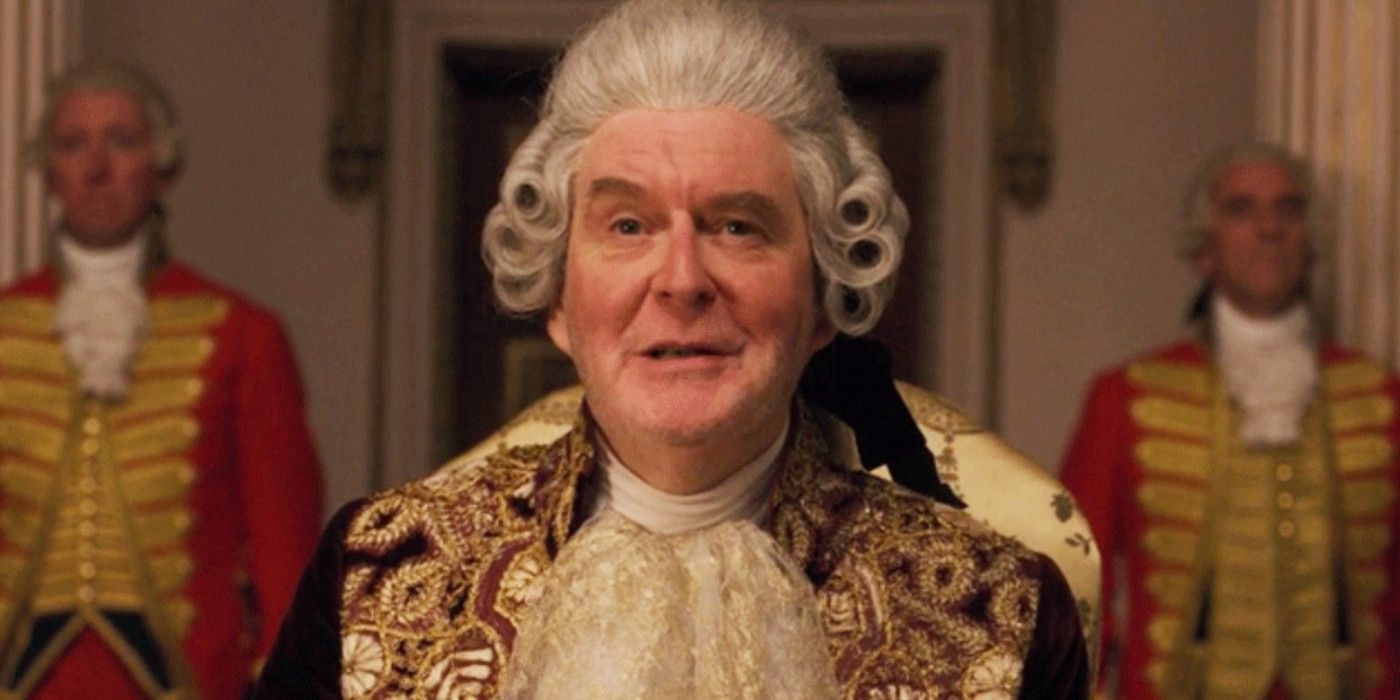In Bridgerton seasons 1 and 2, King George III appears only briefly and is mentioned infrequently – partly because he’s not meant to be a major character and partly because, by that point in time, he was simply too ill to appear publicly. Queen Charlotte, meanwhile, establishes George as a key character, of course. Played in Bridgerton by James Fleet, King George III is portrayed in the spin-off by Corey Mylchreest, in his early 20s.
George III’s three appearances in Bridgerton are initially only relevant because of what they reveal about Queen Charlotte. The brief dinner scene with Queen Charlotte and King George III in the first season provides a somewhat true-to-life explanation for Queen Charlotte’s interest in the fictional Lady Whistledown. As soon as we see how tortured King George III has become, and how much this disturbs his wife, it becomes perfectly clear that Charlotte needs a distraction – and Lady Whistledown provides such a perfectly enveloping and delightful diversion that, at times, Queen Charlotte seems to forget her husband’s poor health. Queen Charlotte goes even further into exploring their romance and their ongoing relationship dynamic, as well as his illness.
The True Story Of King George III’s Illness

Often reductively referred to as the “Madness of King George”, George III’s psychological issues have been a matter of fierce debate over the years. What is not up for debate is the fact that George was unable to continue ruling as a monarch by the time he reached middle age. That prompted his son, George IV, the Prince of Wales to take over the king’s duties, as Prince Regent. Sadly, George III’s incoherency and instability made him a poor face for the royal family, and he was kept out of the public eye to protect the monarchy’s image.
By King George III’s later years, he was kept confined and out of sight, much like he is in Bridgerton. However, unlike Bridgerton, Queen Charlotte had reportedly stopped dining with George. She slept in a separate bedroom from George and refused to be alone with him from 1804 onward. By 1813, when Bridgerton takes place, it’s believed that Queen Charlotte had stopped seeing George altogether. He suffered several extreme periods of ill-health, for a long time attributed to porphyria, and was incarcerated in Kew for his own good. After his final relapse in 1810, the King never recovered and he died in 1820.
King George III’s Illness In Bridgerton

While King George III is mentioned in Bridgerton, he plays a mostly offscreen role, but his illness is very much based on historical accounts of the monarch. According to these accounts, King George III’s illness included symptoms like convulsions, frothing at the mouth, rambling incoherently, bouts of depression and, later in his life, the loss of his hearing, vision, memory, and ability to walk. After the death of Princess Amelia, George sank into a deep depression and never recovered from the loss of his favorite daughter. In 1811, King George III enacted the Regency Act, which allowed his son to function as regent. Queen Charlotte became George’s legal guardian and the king’s mental and physical health continued to deteriorate until his death in 1820.
The exact cause of King George III’s “madness” is a topic of debate among historians and physicians. Until recently, the prevailing theory was that King George III had porphyria (a rare liver disorder) and that his exposure to arsenic contributed to worsening symptoms. Though evidence for King George III having porphyria is well-documented and the theory is still widely accepted, conflicting theories have emerged in recent years. In the last decade or so, scientists, doctors, and historians have posited that King George III did not, in fact, have porphyria, but instead had some combination of bipolar disorder, chronic mania, and dementia. Dr. Peter Garrard of St George’s, University of London went so far as to say, “The porphyria theory is completely dead in the water. This was a psychiatric illness” [via BBC].
What Queen Charlotte Gets Right About How King George Was Treated

King George III was put through medically-approved hell for the sake of “improving his condition”, as Queen Charlotte reveals in horrifying detail. Rather than opting into the treatment, George was moved to Kew by force, by a team of court physicians and then finally leading mental health expert Dr Francis Willis, whose methods were cruel and beliefs misguided. Willis believed mental illness was a product of overexcitement, and the natural remedy was restrictive, calming measures. These included:
- Confinement in a straitjacket
- Skin treatment with arsenic powder (a poison that caused blisters) to “draw unwanted humors out”
- Extreme fasting and purging
- Ice cold baths to shock the illness from his body
- King George was denied cutlery other than a spoon at mealtimes, and forced to eat only soft food like a child
- Total isolation from family
- No remit to leave the house alone, where he was confined to the ground floor only
Unlike in Queen Charlotte, when George was being treated with these torturous methods, which continued throughout his life, Charlotte and his daughter would be at Kew as well. The extent of the treatments are shown in Queen Charlotte, though some of it is left to the imagination, making them arguably even worse.
Queen Charlotte Settles The Debate On King George’s Illness

While the prevailing theory for a long time was that King George was suffering from porphyria – which may well have been the case given the use of arsenic in the “cutting edge” treatments he was subjected to – modern theories suggest King George was suffering from bipolar disorder and possibly schizophrenia, which Queen Charlotte follows the thinking of. George’s condition is clearly something he’s had since he was a child, much to his mother’s dismay, and has been hidden for the sake of the sanctity of The Crown. As King, George cannot show any weakness, and his legitimate medical problems are deemed something that must be cured or hidden at all costs. That’s also why George hides it from Charlotte.
Queen Charlotte clearly falls on the side of modern theories on King George’s “madness”, following the far more sympathetic line that he struggled with debilitating psychological issues – hallucinations, absences, bouts of mania included. While his doctor does suggest that talking through George’s problems is the right approach, that more modern therapy style quickly gives way to physical abuse that simply compounds the King’s condition.





